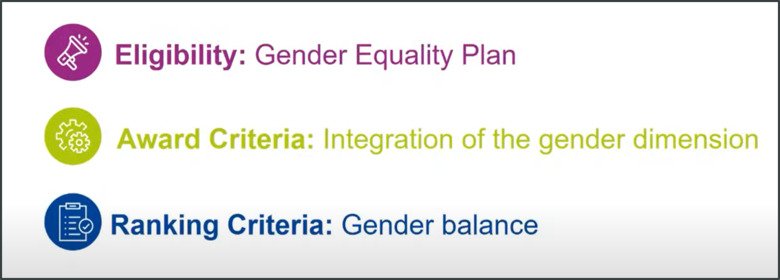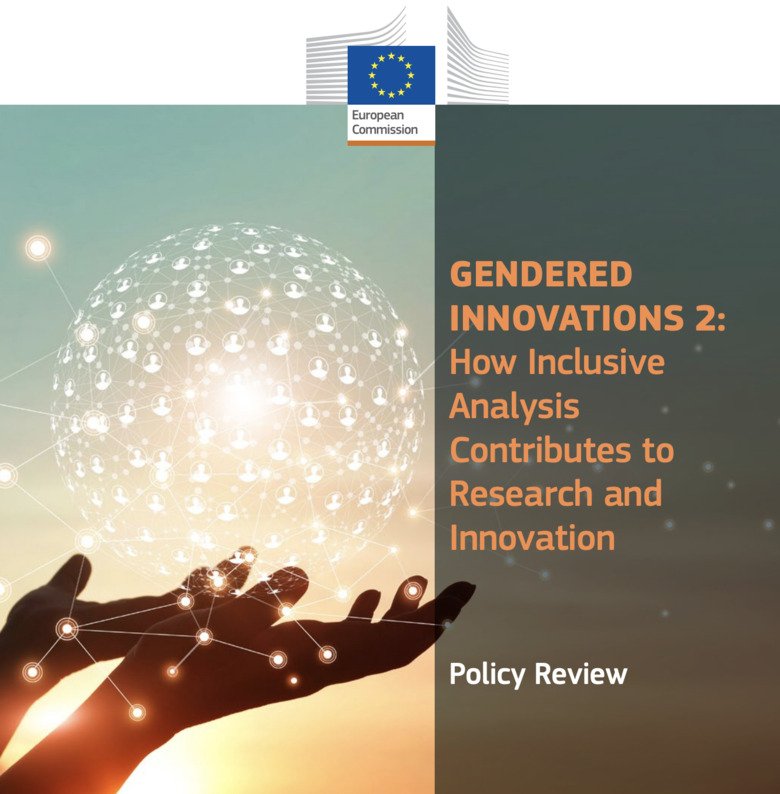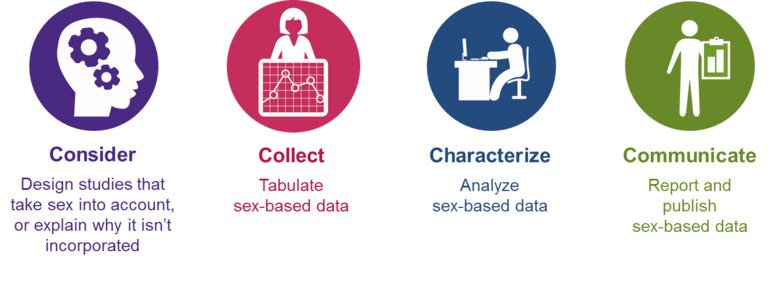Funders' views on sex and gender aspects of research proposals
With competition for research grants becoming ever fiercer, addressing the sex-and-gender dimension of your research can give your proposal that extra edge: Major funding agencies around the world are pushing for sex and gender aspects to be meaningfully integrated into all stages of the research they fund, from study design to data analysis and dissemination. Here we outline the perspectives of several such funding agencies.

European Commission
Horizon Europe, the European Commission's main funding programme 2021-2028, strengthens its commitment to gender equality
In addition to gender balance in research teams, consideration of the sex-and-gender dimension of research pervades Horizon Europe. During the preparation of the Horizon Europe Work Programme, gender experts from different thematic Advisory Groups meet regularly to give their input to the European Commission. Before the evaluation of proposals begins, evaluators receive a tailored briefing on assessing the sex-and-gender dimension; in fact, gender is among the areas of the evaluators’ expertise. Moreover, whereas in the preceding framework programme (Horizon 2020) the integration of the sex-and-gender dimension in proposals was encouraged, in Horizon Europe it is now mandatory across all topics, unless explicitly stated otherwise. And it will be evaluated under the 'Excellence' criterion for Research & Innovation Actions and Innovation Actions. If applicants believe that the sex-and-gender dimension is not relevant to their proposal, they need to explain why it is not relevant.
A 2020 policy report produced by the EU-funded expert group on ‘Gendered Innovations’ provides researchers and innovators with methodological tools for sex, gender and intersectional analysis. It also presents concrete case studies, showcasing projects funded under Horizon 2020 and addressing key research and innovation areas for Horizon Europe clusters, missions, and partnerships. These include areas such as health, artificial intelligence and robotics, energy, transport, marine science and climate change, urban planning, agriculture, fair taxation and venture funding, as well as the COVID-19 pandemic.
 Photo: N/A
Photo: N/AGendered Innovations 2 - a new Policy Review released by the European Commission!
Two years in the making, it is the result of the work of 24 experts. Read about 15 new case studies - on Chronic Pain, Facial Recognition, Smart Mobility, Marine Science, Virtual Assistants etc and revised methods. Sex, gender, and intersectional analysis enhances all phases of research.
Swedish national funding agencies
The Swedish Government has commissioned the Swedish Gender Equality Agency to support all government agencies and state-funded higher-education institutions in their efforts to integrate a gender perspective in all their operations. Although this Gender Mainstreaming in Government Agencies (GMGA) programme deals largely with issues of gender equality, i.e., equal opportunities for men and women, in 2018 the Swedish government issued a directive to national funding agencies—including Vetenskapsrådet, Formas, Forte and Vinnova—to work towards the inclusion of a sex and gender perspective in the research they fund.
Accordingly, Vetenskapsrådet (the Swedish Research Council) announced that from 2020 onwards (and for some of its 2019 calls) all grant applicants will be required to describe whether sex and gender aspects are relevant to their research, and, if so, how they will integrate them into their research plan. Assessment of how such sex and/or gender aspects are addressed in the proposal is now part of the evaluation of the research proposal's scientific quality. Vetenskapsrådet was also a partner in the GENDER-NET Plus ERA-NET Cofund, which aimed to strengthen transnational collaborations to support the promotion of gender equality through institutional change and instigate the integration of sex and gender analysis into research and funding programmes.
Sweden’s innovation agency, Vinnova, fully recognises the prominent role gender plays in innovation. In a book aptly named Innovation & Gender, they set out a wide range of arguments for the importance of the gender perspective in innovation and sustainable growth, illustrating, for instance, how “a gender perspective can help strengthen weak links in innovation milieus and provide a track towards an innovation case for gender diversity”. When it comes to grant proposals, Vinnova also stipulates that the gender dimension of the proposed research should (where appropriate) form an integrated part of the proposal.
The Swedish International Development Cooperation Agency (Sida), a Swedish government agency with the mission to reduce poverty in the world, has developed an extensive Gender Toolbox that provides guidance on how to operationalize gender equality in Swedish development cooperation.
Medical Research Council UK
As of late 2022, the UK's Medical Research Council (MRC) requires sex to be specified in the experimental design of grant applications involving animals, and human and animal tissues and cells. This includes reporting the sex in experiments using cells and tissues. If you don’t know the sex of the cells and tissues you use, you should plan to determine it as part of your proposed research. MRC will expect both sexes of animals, tissues and (non-immortalised) cells to be used as default in research proposals.
MRC may still fund single-sex studies where there is strong justification in the research proposal for doing so. In cases of acutely scarce resources, purely molecular interactions or single-sex mechanisms or diseases, the use of a single sex is likely to be appropriate. Other reasons for conducting research in a single sex given by applicants will be considered as part of the peer review process but should have robust justification. In most cases, female variability is not sufficient as a justification for using only one sex. MRC also does not accept as justification that prior work has been performed in only one sex, or that there is a lack of evidence of sex having an effect.
MRC links to the UK's National Centre for the Replacement, Refinement and Reduction of Animals in Research’s Experimental Design Assistant to help you plan your experiments using both sexes.
US National Institutes of Health
Across the pond, the US federal funding agency NIH takes sex just as seriously. Adding to a 1993 law requiring that women be included in NIH-funded clinical research, the NIH issued in 2015 a policy on Sex as a Biological Variable (SABV), as part of an NIH-wide initiative to improve the reproducibility of publicly funded research through increased scientific rigor and transparency. This policy stipulates that “NIH expects that sex as a biological variable will be factored into research designs, analyses, and reporting in vertebrate animal and human studies. Strong justification from the scientific literature, preliminary data, or other relevant considerations must be provided for applications proposing to study only one sex.” Indeed, the guide for NIH peer reviewers includes a SABV decision tree. The NIH also gives additional funding to researchers who already have NIH grants to allow the researchers to go back and determine whether a sex difference exists in the system they’ve already been studying.
Part of the NIH, the Office of Research on Women's Health was established in 1990 to promote women's health research within and beyond the NIH scientific community. Its website provides extensive information, tools, outreach materials and online courses on integrating sex and gender in research.

Canadian Institutes of Health Research
The Canadian Institutes of Health Research (CIHR), Canada's largest federal funder of biomedical research, is a trailblazer in this arena, having already in 2010 implemented a policy that requires applicants to declare whether and how they will consider sex and/or gender in their proposed research. For certain funding initiatives, the CIHR even requires that applicants include in their team a Sex and Gender Champion; that is, a researcher who possesses or acquires the expertise to "ensure that sex and/or gender considerations are integrated into every step of the research project, as appropriate, including project rationale, experimental design, methods, analysis and knowledge translation". As part of the CIHR, the Institute of Gender and Health provides extensive online information and training about integrating sex and gender in research, as well as a video guiding peer reviewers on how to assess such integration in research proposals. A sex-and-gender expert is also assigned to each peer-review committee to ensure high scientific standards in the discussions about the inclusion or omission of sex and gender in grant applications. Since 2021, reviewers are required to factor the assessment of sex and gender into the overall score of the application.
Take a look at this presentation to learn more about CIHR Institute of Gender and Health's policies and achievements in this area.
Like the US NIH, the CIHR provides incentives in the form of additional funding for basic scientists to factor sex into their experiments. Moreover, it provides Sex and Gender Science Chair grants intended to form a cadre of experts across all disciplines.
Policies and mechanisms addressing sex and gender in research in the EU, US, and Canada
Table comparing the policies and mechanisms adopted by the European Commission, the US National Institutes of Health, and the Canadian Institutes of Health Research.
J Clin Endocrinol Metab. 2021 Oct; 106(10): 3034–3048. J White, C Tannenbaum, I Klinge, L Schiebinger, and J Clayton
In addition to those discussed above, funding agencies in several other countries, including Ireland, France, Norway, Austria, and Spain, have adopted similar policies on incorporating the sex-and-gender dimension in the research they fund, as has the World Health Organization.
